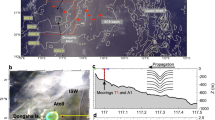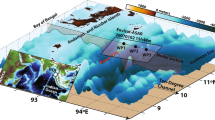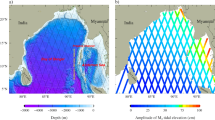Abstract
There are numerous reports of internal waves being 'made visible' on the sea surface by their effect on the surface-wave field and the production of bands of steeper, often breaking, waves separated by zones of relatively calm water1–5. The effect is sometimes quite dramatic. There are accounts of a 'low roar' as the bands of breaking waves, 'walls of white water', pass a vessel6. The bands are sometimes visible from aircraft7, on ships, radar8,9 and are observed from satellites10–15. In the Bay of Biscay 'boils' have been reported on the sea surface in the calm zones, and appear to be related to pulses of nutrients from the thermocline16. The position of the roughest water has been commonly reported to be above the part of the internal wave in which the thermocline is most rapidly falling3,5 (as sketched in Fig. 1) except in very light winds (<3.5 m s−1), when this appears generally to be the calmest zone16. There are, however, few simultaneous observations of surface and internal waves and none, to our knowledge, which has both quantified the frequency of the breaking waves and established their position relative to the internal waves. Here we have used an upward-pointing side-scan sonar to obtain a sub-surface view of bands of rough water and whitecaps on the sea surface associated with internal waves travelling on a pycnocline. The sonar provides a means to measure the surface currents induced by the internal waves, the position, or phase, of the surface-wave breaking relative to the internal waves, and to quantify the frequency of wave breaking. The effect of wave breaking caused by wave–current interaction is to transfer momentum from the surface waves to the currents, with a phase which tends to diminish the internal waves in the cases studied. The enhanced turbulence caused by wave breaking may be effective in mixing or eroding the pycnocline.
This is a preview of subscription content, access via your institution
Access options
Subscribe to this journal
Receive 51 print issues and online access
$199.00 per year
only $3.90 per issue
Buy this article
- Purchase on Springer Link
- Instant access to full article PDF
Prices may be subject to local taxes which are calculated during checkout
Similar content being viewed by others
References
1. Lafond, E. C. Mar. Obs. 37, 10-11 (1967). 2. Fedorov, K. N. & Ginzberg, A. I. Oceanology 26, 1-7 (1986). 3. Osborne, A. R. & Burch, T. L. Science 208, 451-460 (1980). 4. Liu, A. K., Holbrook, J. R. & Apel, J. R. J. phys. Oceanogr. 15, 1613-1625 (1985). 5. Apel, J. R., Holbrook, J. R., Liu, A. K. & Tsai, J. J. J. phys. Oceanogr. 15, 1625-1651 (1985). 6. Perry, R. B. & Schimke, G. R. J geophys. Res. 70, 2319-2324 (1965). 7. Shand, J. A. Trans. Am. geophys. Un. 34, 843-856 (1953). 8. Cavanie, A. Mem. Soc. R. Sci. Liege Ser. 6 2, 27-44 (1972). 9. Veselov, V. M., Davydov, A. A., Shachkov, V. A., Chernyy, I. Z. & Volyak, K. I. Izvestya 20,232-238 (1984). 10. Soules, S. D. Deep Sea Res. 17, 191-195 (1970). 11. Apel, J. R., Byrne, H. M., Prom, J. R. & Charnell, R. J. J. geophys. Res. 80, 865-881 (1975). 12. Trask, R. P. & Briscoe, M. B. J. geophys. Res. 88, 1789-1799 (1983). 13. Alpers, W. & Salusti, E. J. geophys. Res. 88, 1800-1808 (1983). 14. Hughes, B. A. & Gower, J. F. R. J. geophys. Res. 88, 1809-1824 (1983). 15. Thompson, D. R. & Gasparovic, R. F. Nature 320, 345-348 (1986). 16. Holligan, P. M., Pingree, R. D. & Mardell, G. T. Nature 314, 348-350 (1985). 17. Lafond, E. C. in The Sea Vol. 1 (ed. Hill, M. N.) 731-751 (Wiley, New York, 1962). 18. Thorpe, S. A. & Hall, A. J. Continental Shelf Res. 1, 353-384 (1983). 19. Thorpe, S. A., Hall, A. J. & Hunt, S. Nature 306, 167-169 (1983). 20. Donelan, M., Longuet-Higgins, M. S. & Turner, J. S. Nature 239, 449-451 (1974). 21. Thorpe, S. A. J. Fluid Meek 63, 509-527 (1974). 22. Mitsuyasu, H. J. J. geophys. Res. 90, 3343-3345 (1985). 23. Melville, W. K. & Rapp, R. J. Nature 317, 514-516 (1985). 24. Heathershaw, A. D. Geophys. J. R. astr. Soc. 58, 295-430 (1979). 25. Sanford, L. P. & Grant, W. D. J. geophys. Res. 92, 1828-1844 (1987). 26. Pingree, R. D., Mardell, G. T. & New, A. L. Nature 321, 154-158 (1986). 27. New, A. L. Deep Sea Res. (in the press). 28. Gargett, A. E. & Hughes, B. A. J Fluid Mech. 52, 179-191 (1972). 29. Gibers, D. J. & Herterich, K. Fluid Mech. 92, 349-379 (1979). 30. Yefimov, V. V., Kuklin, A. K. & Solov'yeir, Yu. P. Izvestya 20, 560-564 (1984).
Author information
Authors and Affiliations
Rights and permissions
About this article
Cite this article
Thorpe, S., Belloul, M. & Hall, A. Internal waves and whitecaps. Nature 330, 740–742 (1987). https://doi.org/10.1038/330740a0
Received:
Accepted:
Issue Date:
DOI: https://doi.org/10.1038/330740a0
This article is cited by
-
Interaction between the surface and internal waves: The modulation and maser mechanisms
Physical Oceanography (1993)
Comments
By submitting a comment you agree to abide by our Terms and Community Guidelines. If you find something abusive or that does not comply with our terms or guidelines please flag it as inappropriate.



